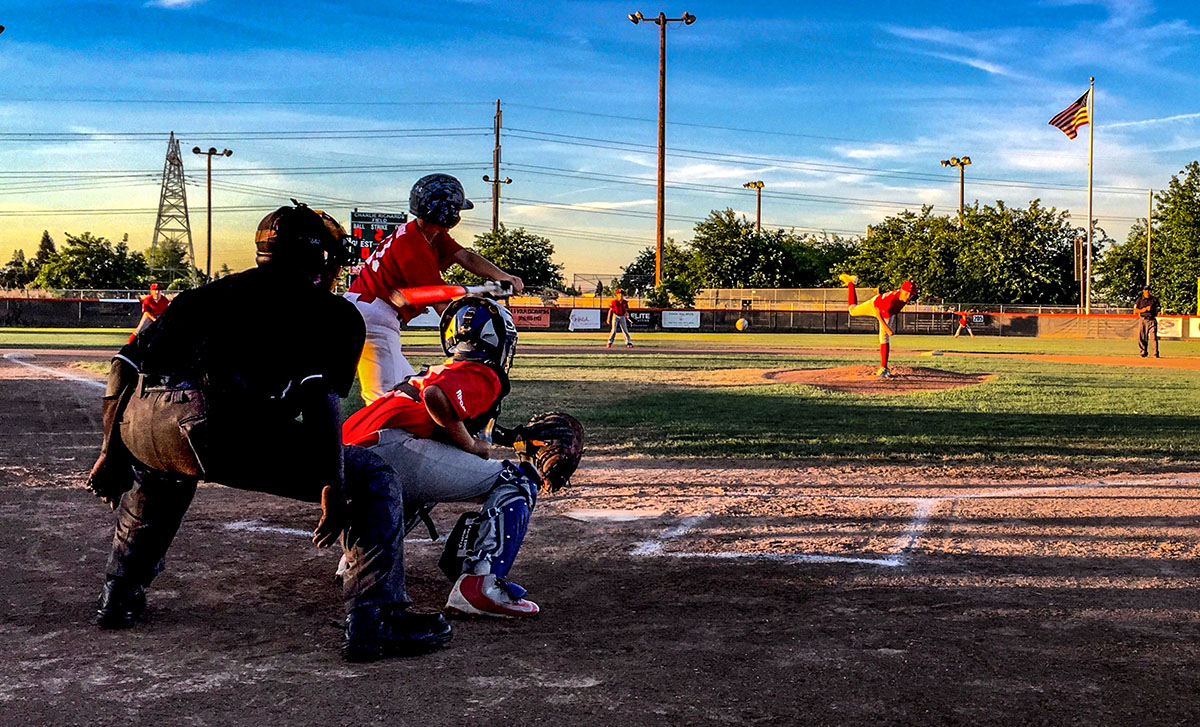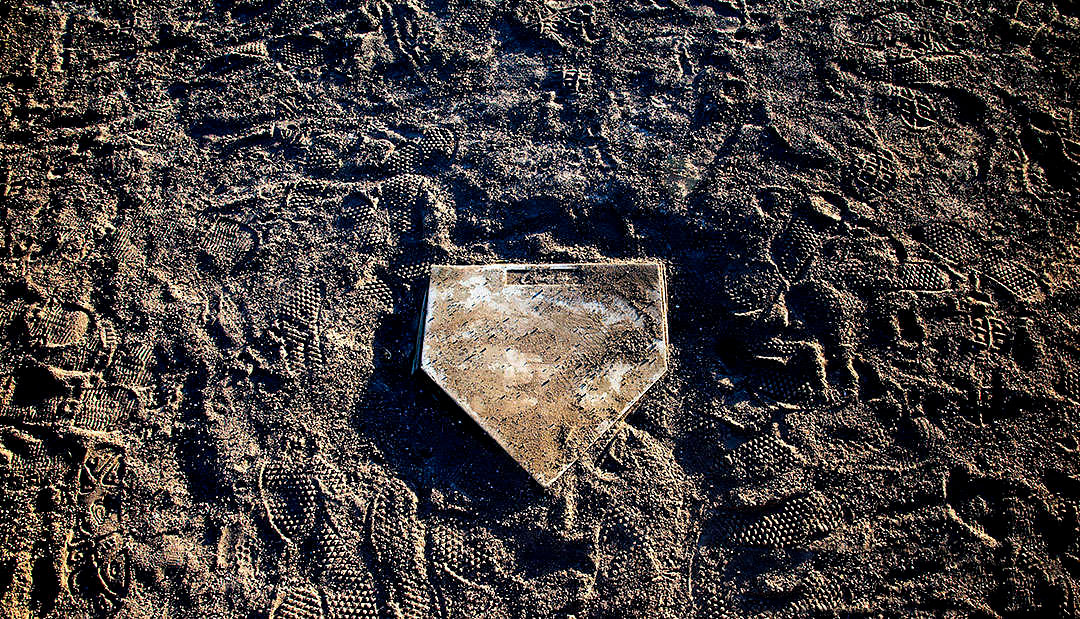A Diamond is a Boy’s Best Friend
- By Rich Turner
- Photographs by Rich Turner
- March 30, 2019
- 6:00 am
- 5 Comments

“You can’t go back home to your family, back home to your childhood… back home to a young man’s dreams of glory and of fame… Thomas Wolfe
With Spring comes baseball. And baseball, for me, ignites memories.
Isleton is a small, quiet Delta river town that hasn’t seemed to change in the forty-some years I’ve been roaming the California Delta. Roseville, a little northeast of Sacramento, was a bit larger, and it’s where I spent my elementary school years in the late 1950’s. In many ways Isleton is similar and perhaps that’s the draw for me. Nostalgia. Sights and sounds that conjure up memories of days long gone.

Just off one of the main roads leading into this historical town on the Sacramento River is a Little League baseball diamond. A couple summers ago I was passing through as a game was in progress and I decided to stop and watch a few at-bats for old time’s sake. Funny how it’s possible to enjoy this game even though there is no personal relationship with any players or their families. One inning was all I had time for before I needed to continue on to my planned destination but there was just enough action, with dust flying in a close play at home and both sides cheering on their own, that sparked memories of about 20 years ago when my son, Jake, was playing and I would occasionally drive the two of us to that diamond to hit a few and play some catch when we had the place to ourselves. Remembering those good times at the Delta ball yard naturally took me back to my own Little League days.
It doesn’t matter that I only lived there for 6 years back in the late 50’s. It doesn’t matter that I’ve established my home, profession, raised my kids, and have many friends and deep roots in Stockton after traveling the world. I’ll always consider Roseville my home town. Recently, I had a little extra time on my hands and coincidently found myself near enough to pay a visit to Charlie Richards Field, my old Little League diamond, on the hunch that a game might, just might, be in progress. Jackpot!
Taking a seat in the stands was like having set the controls of the H. G. Well’s “Time Machine” to 1958 when I was 11 years old. Memories began rushing in like a Texas flash-flood. I played on the 1958 and 1959 Yankees. We were the league champs in 1959 and I still have the ‘gold’ baseball-on-a-chain that each player was presented on the field after our final win for proof. Of course the ‘gold’ was actually copper and it has tastefully tarnished over the years.
The Angels and Reds are playing this night and infield practice is about to give way to the meeting of managers and umpires at the plate. I played on that field’s first full season in 1958 and the next as well. The ball yard is meticulously cared for now just as it had been in my day when it was new. It was innovative at the time because it was one of the few Little League diamonds with lights allowing night games. It was exciting to be there. I was proud.
My recent visit, though, was a bit disappointing. The original cinder block-framed grandstand had been demolished and replaced by run-of-the-mill aluminum bleachers. In and of itself, not a big deal but in dead center of the back of the high – to my 12 year old self – wall was a piece of black polished granite honoring Charlie Richards. Right below his name was also chiseled these words, “A diamond is a boy’s best friend.” I thought those words were clever then and still do, although I haven’t been able to find the origin of that phrase other than the substitution of the word “boy’s” for ‘girl’s” in the song made famous by Carol Channing in the 1949 Broadway production, “Gentlemen Prefer Blondes”. I hope someone saved that plaque – as far as I’m concerned it belongs in a museum.
Another slight disappointment for me was the lack of an announcer. The batters came to the plate without names amplified for the crowd as had been done in my day. There was a scoreboard operator behind home plate and it wouldn’t be too difficult to plug in a mic and have someone read the names of the batters.
I mention this because it was one of the biggest thrills of my 12-years of life; that of having my name come over the PA system for all to hear as I swaggered toward the plate with a death-grip on my own Adirondack bat bought with Sacramento Bee paper route money at Wolfe and Royer Hardware in downtown Roseville. I’m wearing my baggy Yankees uniform, a couple sizes too large complete down to the stirrup sox, knicker-high pants and numbered jersey. Itchy wool, mind you, not the polyester of today. Our cleats were rubber, not steel. Hey, we were kids.

Then, an aging Charlie Richards himself would say my name, MY NAME, so that EVERYONE in the stands could hear. “The batter is Turner!” crackled through the overhead speakers. Talk about pressure. If I made a fool out of myself I wouldn’t be doing it anonymously.
In the batter’s box I always felt intimidated; I was a bit small for my age. Those goliaths (to me, least) out there on the mound, only 46 feet away, had trouble finding my narrow strike zone so I got on base by walking more than I did by hitting. Drawing a walk is as good as a hit, right?
Speaking of hitting, our bats were wood then, not aluminum like today. On the rare occasions I did connect, there was a satisfying sound that cannot be duplicated by the cheap-sounding aluminum ‘ting’ we hear today. Left and right field fences are 202 feet away with center field 206. That didn’t matter to me, I would never put a ball anywhere near that fence. Except for the time I smacked a line drive in the gap between left and center and the ball took a fortuitous odd bounce. Stand-up triple! Glory days…
In the field I was a fair to middlin’ second baseman, the only position I ever played. Interesting how in one inning I could make a decent play or two and have the pleasure of lots of pats on the back entering the dugout. Then, in another inning, boot a play that allows a run and the silence is thick as Delta fog in January. Kids will be kids.
Remember the milk man? Tom McNeil was ours. His day job was delivering Golden State dairy products in glass bottles to our front porch before sunup. He was also our coach. He was kind of a quiet guy and a good, patient teacher of the game and more interested in our learning skills and sportsmanship than actually winning. I never saw him upset or even disappointed when we lost or when someone made a dumb move. Winning certainly met with his approval but not in a way that made us feel like winning was the be-all-end-all. He started coaching Little League when his son became old enough to play. That had been some years before I showed up but he loved coaching so much that he continued – much to our benefit. After every game, win or lose, he would pile us into the back of his pickup truck (today a very big no-no) and take us all down to the little Dairy Queen for ice cream cones.
When I left the Navy years later and started working at the Roseville Press Tribune, I tried to look him up to say hi and thanks. Sadly, I was a few years too late; he had died way too young. Coach McNeil taught us to do our very best every day, to lose and to win gracefully, and to always take pride in ours and our teammates efforts. And, above all, to have fun. To this day I wish I could thank him personally for some darned fine memories.
George Webber, the main character in Thomas Wolfe’s 1940 novel, “You Can’t Go Home Again”, realizes, “You can’t go back home to your family, back home to your childhood… back home to a young man’s dreams of glory and of fame… back home to places in the country, back home to the old forms and systems of things which once seemed everlasting but which are changing all the time…”
Remembering one’s youth is not as fulfilling as the creation of those memories. But one can revisit the places of memory creation, though family, friends, neighbors, school and team mates have all long-since moved on. When I do this it’s like awakening long-napping fond memories. Funny how not-so-good memories tend to stay dormant. I like that part.

Can we really go home again? As George Webber indicates, and has become evident in occasional visits to my hometown, not in the literal sense. There is the geographical place, the houses, businesses, schools, and ballparks we remember as kids and refer to as home. But in reality home is gone because the people are gone, too. It’s the people that make home home. The memories can make it seem real even if it is not – it can feel like it was just yesterday, as folks of a certain age are fond of saying.
Yes, we can relive those events of long ago, those events that helped shape who we have become many years later, but only in the time machine of our minds. Visiting the ballparks in Isleton and Roseville recently with games in progress definitely fueled the fires of my virtual time machine.
Sweet.
Award-winning photographer, Rich Turner, explored, photographed, and aerial photo-mapped Antarctica as a Navy photographer, was a newspaper photojournalist for 19 years, and has operated his own fine art photography studio since 1990. “Delta Grandeur,” his traveling exhibit, toured California museums and libraries for 5 years. His most recent passion is spreading the word far and wide about what an amazing place the Delta and Greater Bay Area is. With the help of very talented writers, artists and photographers, publishing this magazine seems a good way to do that.
- By Rich Turner
- Photographs By: Rich Turner
- March 30, 2019
- 6:00 am
- 5 Comments

Leave a Reply
5 Comments
What a great remembrance of a simpler time, when Little League was to have fun and maybe teach a few lessons of the game and about being a good teammate and person. It makes me recall all my own memories of Little League. My dad was president and my mom was treasurer of the Cupertino National Little League and we spent almost every weeknight at the fields, even if my brother’s team was not playing. It was a very big part of childhood. Thanks, Rich, for stirring those memories.
Glad to hear that, Lori. How wonderful your mom and dad were so involved! What I find amazing is that I only played organized ball about 3 years, quitting when I was 12. Yet so much more than the game has infused my life since, not to mention vivid memories. I still can’t drive by a game in progress anywhere and not be tempted to stop and watch for a while.
Rich, freaking love this. Good job. No, great job! I also dig the old glove art. Nice.
Thank, you, William, great compliment coming from you and means much!
Thank you, William West!